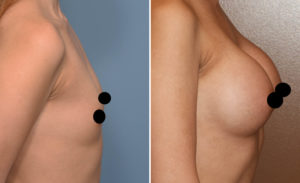Background: Breast implants are most commonly placed in the submuscular pocket, more technically known as the dual plane or partial submuscular pocket. There are several different incisions in which to access and create this pocket including the inframammary, areolar and transaxillary incisions. Each incisions has its advantages and disadvantages as well as surgeon advocates. With good technique any of these three incisions can produce excellent outcomes with good scar outcomes.
The transaxillary incision for breast augmentation is of great appeal to many women as it keeps the scar off of the breasts. It has been criticized by some surgeons as having an increased risk of infection going through the hair-bearing axilla, being too small to place silicone implants through and not being able to adequately release the inferomedial muscle to get good implant positioning. Having done many transaxillary breast augmentations over the past twenty-five years I have not found any of these three conners or disadvantages to the generally true.
The transaxaillary approach has not shown any increased risk of infection in my experience. The funnel device permits silicone gel implants to be placed fairly easily up to 500ccs volume in most patients. Adequate release of the pectoralis muscle can be done in women that have a non-sagging breast mound. Patient selection for the technique is key.
Case Study: This young female desired breast augmentation to balance out her body with little breast tissue and wider hips. She was very petite at 5’ 1”tall and 107lbs. She had A cup-sized breasts with an 11cm breast base diameter.

The transaxillary approach provides the shortest distance from the skin to enter under the pectoralis muscle. It is also the location of the widest distance between the pectorals major and minor muscles for efficient pocket location and development. It is a relatively avascular plane with the only potential bleeding along the inframammary crease dissection/release. Doing this release without direct visualization is an art form but it has not led to any increased risk of postoperative hematoma development.
Case Highlights:
1) The transaxillary incisional approach can be used for saline, Ideal and silicone gel breast implants.
2) The non-endoscopic transaxillary approach works well for women that do not have breast tissue sagging.
3) The funnel insertion method permits silicone implants to be placed up to 500ccs in volume.
Dr. Barry Eppley
Indianapolis, Indiana


